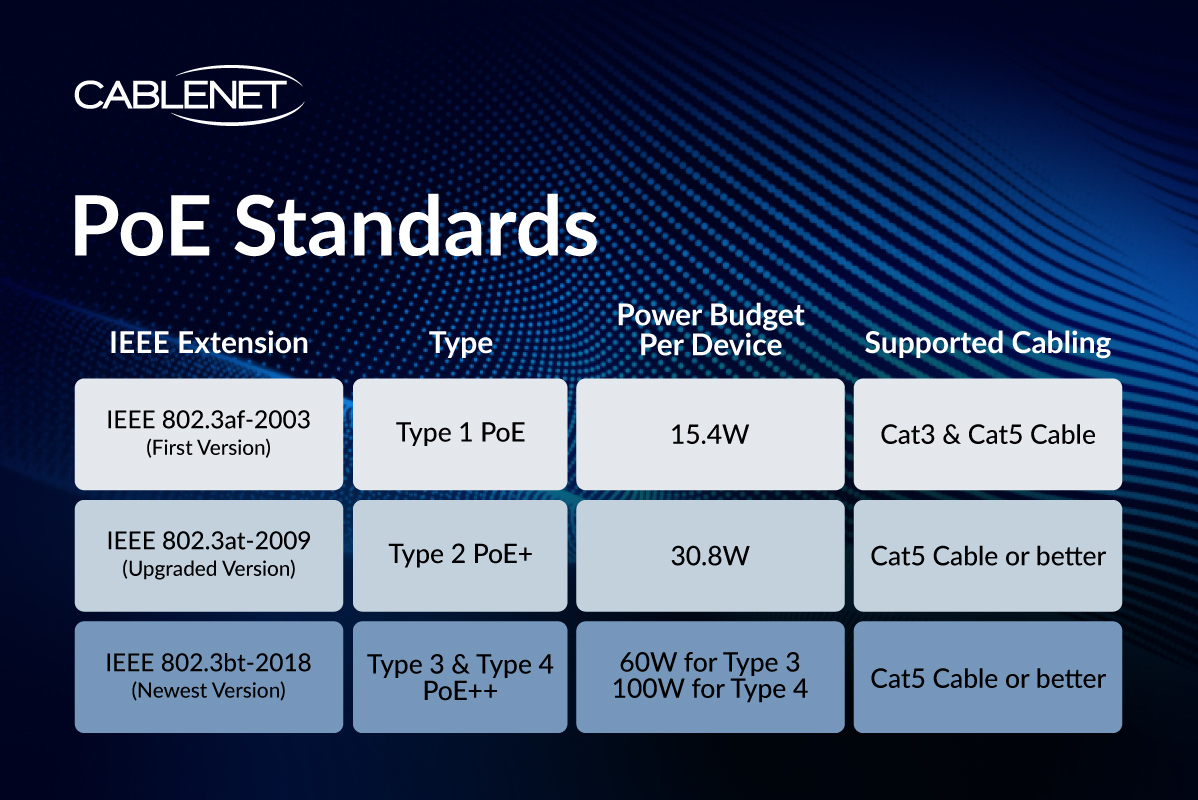Valuable Tips for Selecting PoE Cables
The selection of proper PoE cable is significant in order to realise an effective and reliable network transmission.
Power Over Ethernet Standards
Power over Ethernet (PoE) is a tried and tested method of providing DC power over the same cabling used for network data transmission. The Institute of Electrical and Electronics Engineers (IEEE) standards for PoE are 802.3af, 802.3at, and 802.3bt, presented as follows:

PoE Applications
PoE is a technology used in many applications – IP cameras, VoIP telephones, Wireless Access Points, and many more.
However, PoE can’t recognise the maximum requirement without the correct cabling and network design choice, or you may encounter some connectivity issues. Cabling standards bodies are working on expanding the potential of PoE whilst addressing performance and safety issues. Consequently, selecting the right Power over Ethernet cable is essential.
PoE Cable Selection Considering Factors
Choosing a suitable cable is essential to network quality and reliability. What should be taken into consideration when selecting PoE network cables? It would be best to consider several factors when determining the cable used in PoE applications.
Conductor Size
Conductor resistance can generate heat within the cable used in PoE applications. Cat6 and Cat7 cables have larger conductor sizes than Cat5e, and using cables with a larger conductor size can significantly reduce conductor resistance. Generally speaking, this will reduce the heat generated in the cable with a similar ratio to the reduction in conductor resistance. Basically, The bigger the conductor size, the better.
Cable Construction
The construction of a given cable can also be a factor causing temperature rise within a cable. You can divide copper cables into two types based on their structure, unshielded twisted pair cable (UTP) and shielded twisted pair cable (STP). Cables with metallic or foil shields dissipate more heat than UTP cables, and higher heat dissipation leads to a much cooler cable. Using a Cat6 F/UTP cable, over 40% of the heat can be dissipated compared to the UTP version of the same cable. If the cabling design and budget allow it, choosing a Cat6 S/FTP cable, where each pair is shielded, can dissipate more heat than a Cat6 and Cat6 F/UTP cable.
Cable Temperature
The two factors mentioned above will affect the temperature of a cable to some degree. A typical operating temperature range for network cables is -40 to 60 degrees Celsius. Cables operating above this range may suffer electrical performance degradation, which is not desirable for the cable’s longevity. As mentioned above, unshielded cables are more likely to be affected by higher temperatures than shielded cables.
Cable Materials
When selecting cables to use in a PoE network, you need to make sure that you are comparing like for like. Copper-clad aluminium (CCA) cables use a coated aluminium conductor instead of a pure copper conductor found in pure copper cables. Some people may choose copper-clad aluminium cables due to budget restraints, but using inferior CCA cables may lead to issues in your network. CCA cables have much higher resistance than copper cables. The voltage drop will be more significant for any channel length if you don’t compensate for the higher resistance. Longer cable runs will exceed the TIA’s channel DCR requirements, thus limiting the voltage available to the device. Higher resistance also causes radiant heat to build up faster, with the potential that it may cause damage to the device.
100% pure copper network cabling is a safer and more reliable choice for PoE applications.
Power Consumption
When choosing PoE cables, you must recognise the power the PoE devices require for operation. The power requirements will dictate which IEEE standard to follow and the minimum category cabling to use. Although each standard dictates a minimum category of cabling, voltage drop and heat dissipation are other factors you need to consider. Voltage drop is how much power reaches the receiving device. The energy lost over the cable’s length transforms into heat, known as heat dissipation. Excessive heat build-up can cause a drop in electrical performance and premature ageing of the cable sheath.
Data Transmission Requirements
Devices like megapixel IP cameras may require higher-grade PoE cables to deliver the video signal and the power needed to operate the device.
Installation Configuration
The last factor is the cable installation method, which can significantly affect the ability to dissipate heat. Larger cable bundles will retain heat, so consider reducing the number of cables within a bundle.
Some installation tips for PoE cabling:
- Get well-prepared before deploying.
- Are your network devices PoE compliant?
- Use of different media in the cabling design.
- Don’t run cables close to devices that generate electromagnetic interference (EMI).
- Think ahead and try to future-proof your installation design.
Cablenet: A Trusted Supplier of PoE Cable
A reputable cable supplier should only offer cables of high quality and reliability. Cablenet encompasses a wide range of high-quality Cat5e, Cat6 and Cat6a PoE cables with shielded or unshielded options.
